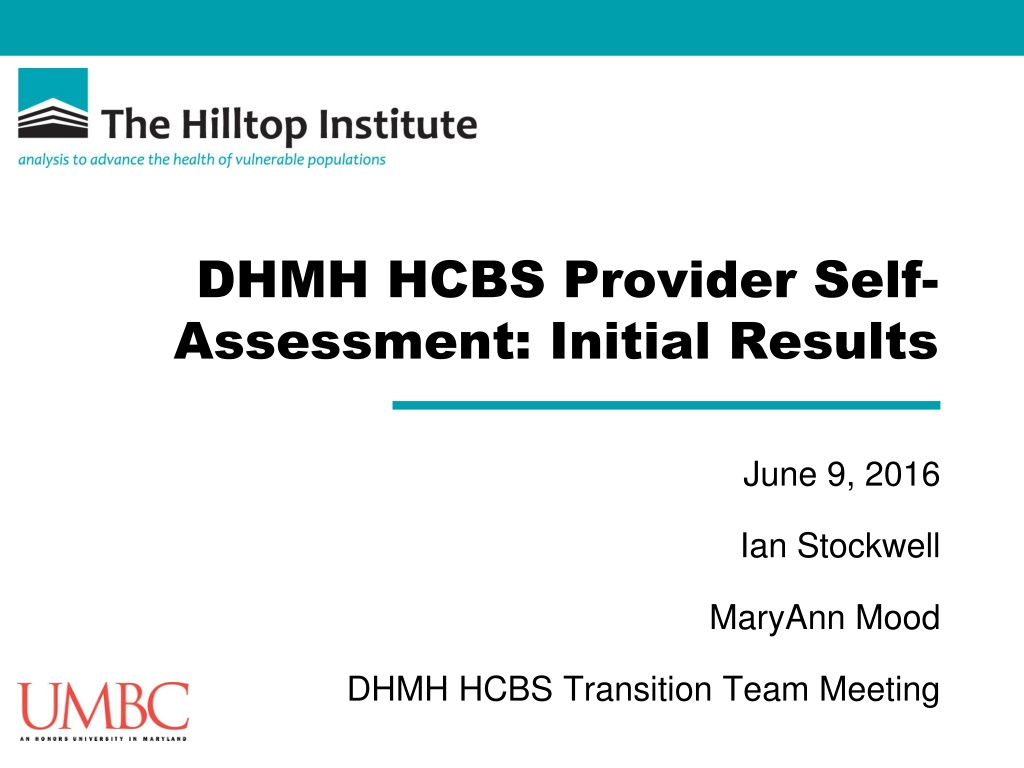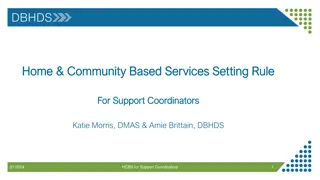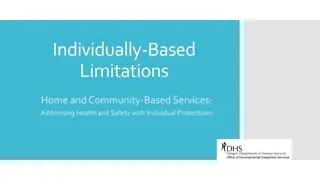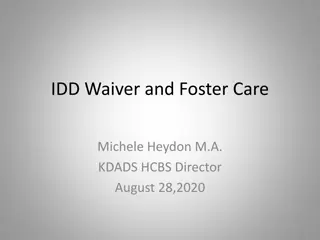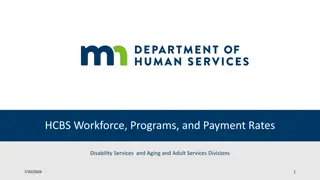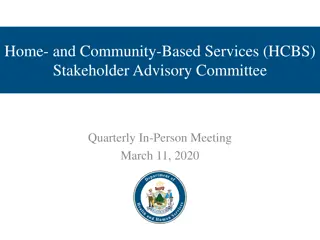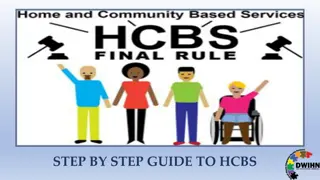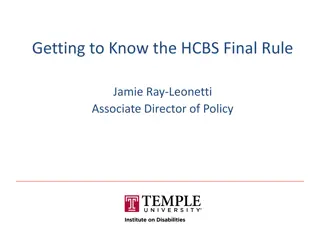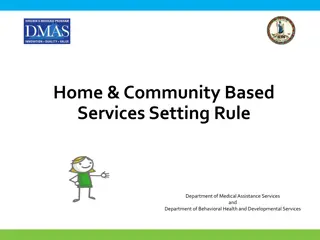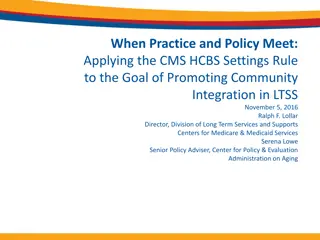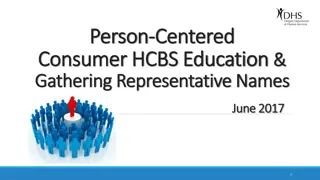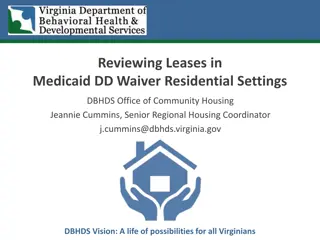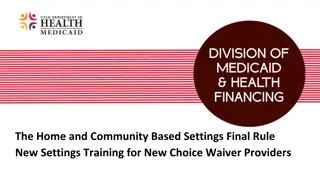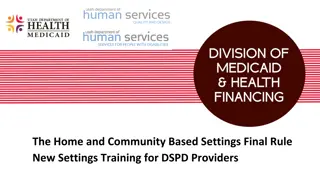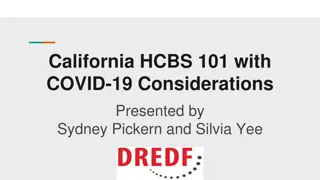Analysis of HCBS Self-Assessment Results and Service Settings
The analysis of HCBS self-assessment results from June 9, 2016, reveals that 865 assessments were completed by waiver providers in various service settings such as Residential Habilitation, Therapeutic Integration, Medical Day Care, Senior Center Plus, and Assisted Living. Providers indicated the services they offered at each site, with breakdown percentages shown. An in-depth analysis approach was taken, linking relevant questions to regulations in the HCBS community settings final rule. Non-compliance was identified and flagged for further attention. Key questions regarding site location, types of services provided, physical isolation, and community access were highlighted for evaluation.
Download Presentation

Please find below an Image/Link to download the presentation.
The content on the website is provided AS IS for your information and personal use only. It may not be sold, licensed, or shared on other websites without obtaining consent from the author. Download presentation by click this link. If you encounter any issues during the download, it is possible that the publisher has removed the file from their server.
E N D
Presentation Transcript
hilltop_left_w_tag DHMH HCBS Provider Self- Assessment: Initial Results June 9, 2016 Ian Stockwell MaryAnn Mood DHMH HCBS Transition Team Meeting
Who Completed the HCBS Self- Assessment? Waiver Providers Community Options Waiver Medical Day Care Waiver Autism Waiver Service Settings Assisted living (AL) Senior center plus (SCP) Medical day care (MDC) Therapeutic integration (TI) Residential Habilitation (RH) -2-
Assessments Completed and Services Indicated 865 assessments were completed Providers indicated which services they provided at the site Providers were able to indicate if multiple services were provided -3-
Service Setting Breakdown Residential Habilitation, 3% (29) Therapeutic Integration, 4% (36) Medical Day Care, 14% (124) Senior Center Plus, 3% (29) Assisted Living, 76% (693) -4-
Analysis Approach Relevant questions/indicators were linked to specific regulations within the HCBS community settings final rule DHMH developed a compliant/non-compliant coding scheme (see next page) -5-
Analysis Approach continued The compliant/non-compliant coding scheme Providers who were non-compliant on any one indicator for a regulation were deemed non-compliant for that specific regulation A table of the providers determined to be non-compliant was produced by service setting for each specific portion of the regulation Additional key questions were denoted as red flag questions (see next page) Non-compliance on these questions may require more immediate attention from DHMH -6-
Analysis Approach continued Red flag questions Is the site located in one of the following? (answer choices include the different institutional types) Is the site located on the grounds of, adjacent to, or in a building that is also a publicly or privately operated facility that provides inpatient institutional treatment? Are multiple types of services (e.g., housing, day services, medical, behavioral, and/or social and recreational activities) provided at this site? Is the site physically isolated from the greater community? (i.e., gated setting, secured community, farm community, or campus setting) Do participants access the broader community (i.e., go to places not located at the site)? Are participants and/or their legal representatives given information regarding how to make changes to their services? Does the site have physically accessible bathrooms for participants to use? -7-
Summary of Coding Scheme Summary of Coding Scheme Number of Questions/Summary of Question(s)* Regulation 1 Is the site located in one of the following? (choices include institutional types and none of the above) Setting is institutional 7 physical location of setting, service provisions, and members of the community at the site Settings has presumed qualities of an institution Setting is integrated and supports full access to the community 6 participant control of funds and access to the community Setting is picked by the individual - options include non-disability setting and private bedroom 2 services received in non-disability specific setting and an option of a private bedroom is given (for residential settings) Setting ensures individuals' rights to privacy, dignity and respect, and freedom from coercion and restraint 6 participants information is kept private, participants treated with respect, informed consent regarding cameras and restrictive interventions is granted 4 participants have unrestricted access to all areas of the site and are permitted to drink, vote, and choose who to interact with during group activities Setting optimizes individual autonomy and independence in making life choices 2 participants asked about their needs and preferences regarding services and are given information regarding how to make changes to their services Setting facilitates individual choice regarding services and supports 5 physically accessible bathrooms, kitchens, laundry rooms, and furniture (laundry and kitchen were in the residential section of assessment) The setting is physically accessible to the individual Individuals have the freedom to control their own schedules and have access to food at any time Residential Settings 4 freedom to come and go and access to food (including when, where and what type) 1 Do participants have a lease or other legally enforceable document that describes their rights? Individuals must have a lease or residency agreement Individuals must have privacy in their sleeping or living unit (locking doors, availability of keys, choice of roommate, freedom to decorate) 14 roommate choice, locking doors and key access, private space for communication with others, and freedom to decorate 1 Are participants able to have visitors at any time of the day (i.e., 24 hours a day)? Individuals are able to have visitors at any time -8-
Overall Provider Compliance Status* Sites Percentage Not Compliant 860 99.4% Compliant 5 0.6% Total 865 100.00% *Not compliant = a provider was not compliant on at least one indicator. Compliant = a provider was compliant on all indicators. The majority of providers are currently non-compliant with the final rule It is important to note that the rule is new The purpose of the self-assessment was to identify the areas of non-compliance so that the state can provide assistance as necessary -9-
Red Flag Questions Number of Non-Compliant Red Flag Questions Number of Sites Percentage 0 308 35.8% 1 385 44.8% 2 122 14.2% 3 38 4.4% 4 6 0.7% 5 1 0.1% Total 860 100.0% A little over a third (35.8%) of provider sites that have been deemed non- compliant are compliant on all of the red flag questions 64.2% of providers deemed non-compliant are non-compliant on at least one red flag question -10-
Provider Setting Sites Non Provider Setting Sites Non- -Compliant, by Regulation Compliant, by Regulation Service Setting Sites* Regulation AL SCP (N=29) MDC (N=124) TI RH (N=639) (N=36) (N=29) 5.2% (36) 77.9% (540) 74.0% (513) 56.0% (388) 9.7% (67) 77.5% (537) 17.6% (122) 52.7% (365) 31.6% (219) 3.4% (1) 86.2% (25) 44.8% (13) 51.7% (15) 10.3% (3) 27.6% (8) 13.8% (4) 3.4% (1) 51.7% (15) 4.8% (6) 77.4% (96) 20.2% (25) 38.7% (48) 15.3% (19) 29.8% (37) 11.3% (14) 4.8% (6) 46.8% (58) 2.8% (1) 91.7% (33) 33.3% (12) 30.6% (11) 16.7% (6) 38.9% (14) 22.2% (8) 16.7% (6) 25.0% (9) 6.9% (2) 93.1% (27) 82.8% (24) 37.9% (11) 10.3% (3) 58.6% (17) 20.7% (6) 58.6% (17) 31.0% (9) Setting is institutional Settings has presumed qualities of an institution Setting is integrated and supports full access to the community Setting is picked by the individual - options include non-disability setting and private bedroom Setting ensures individuals' rights to privacy, dignity and respect, and freedom from coercion and restraint Setting optimizes individual autonomy and independence in making life choices Setting facilitates individual choice regarding services and supports The setting is physically accessible to the individual Individuals have the freedom to control their own schedules and have access to food at any time Residential Settings 1.6% (11) 91.9% (637) 17.2% (119) 0.0% (0) 6.9% (2) 0.0% (0) 0.0% (0) 5.6% (7) 0.8% (1) 2.8% (1) 13.9% (5) 5.6% (2) 44.8% (13) 96.6% (28) 20.7% (6) Individuals must have a lease or residency agreement Individuals must have privacy in their sleeping or living unit (locking doors, availability of keys, choice of roommate, freedom to decorate) Individuals are able to have visitors at any time *If a provider identified more than one service, it will show up under each service setting. Additionally, it appears that some providers misidentified their services. -11-
Questions? -12-
About The Hilltop Institute The Hilltop Institute at UMBC is a non-partisan health research organization with an expertise in Medicaid and in improving publicly financed health care systems dedicated to advancing the health and wellbeing of vulnerable populations. Hilltop conducts research, analysis, and evaluations on behalf of government agencies, foundations, and nonprofit organizations at the national, state, and local levels. Hilltop is committed to addressing complex issues through informed, objective, and innovative research and analysis. www.hilltopinstitute.org -13-
Contact Information Ian Stockwell Director of Long-Term Services and Supports The Hilltop Institute 410-455-6728 istockwell@hilltop.umbc.edu MaryAnn Mood Policy Analyst The Hilltop Institute 410-455-6395 mamood@hilltop.umbc.edu -14-
